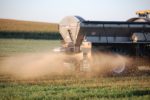Advertise Follow Us
Articles Tagged with ''Gypsum''
Obsession With Soil Health Paves Way For Better No-Tilling
Indiana no-tiller Dave Chance uses a combination of compost, cover crops and vertical tillage to tame high-clay soils and boost yields.
Read More
What I've Learned from No-Tilling
Nudging No-Till Yields From Every Direction
Indiana no-tiller Jack Maloney finds mastering many production practices is the key to pushing no-till corn and soybeans yields higher.
Read More
No-Till Notes
Building A Better No-Till Soil
Gypsum, cover crops, manure and even vertical tillage can be part of a multifaceted no-till system that improves soil health and brings in higher yields.
Read More
Get The Most From Foliar Feeding Corn And Soybeans
Enhancing the nutrient efficiency of plants through the leaves is not only possible, but profitable, with the right level of management.
Read More
Gypsum Balances Nutrients, Builds Up Soil Structure
Proper applications of gypsum, an efficient carrier of soluble calcium, can help no-tillers improve the soil environment for plants and reclaim problematic sodic soils.
Read More
What I've Learned from No-Tilling
Balanced Soil Is The Base For Strip-Till Success
When making farm-management decisions, second-generation strip-tiller Bill Darrington considers the impact on soil life and structure from every angle.
Read More

.png?height=125&t=1731942302&width=150)









